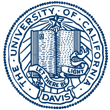
This REU program was funded through NSF PHY-1560482.
Students' names link to their final papers. Advisors' names link to the research group web pages.

Astrophysics
When light passes near a very heavy object, such as a black hole, its path bends. When the massive object is directly between Earth and some distant galaxy, portions of the light from the galaxy can bend around the object in different directions, giving rise to multiple images of the galaxy in our telescopes. In less extreme cases, the gravitational lensing effect merely distorts the appearance of a galaxy. Hunter Martin (Solano Community College; advisor David Wittman ) modelled how to extract the effects of gravitational lensing from telescope images. When a given galaxy shape is observed, how much of that is real, perhaps coming from the angle at which we view that galaxy, and how much of it is distortion from the path the light takes to reach us? Hunter explored how much velocity information, which can be obtained by spectroscopic analysis, can improve the lensing analysis. He showed that the velocity data can be very helpful and found criteria for choosing the best places to use it. This last piece matters because the spectroscopic data take far longer to acquire and would be used only to complement simpler images.
Biological Physics
Protein synthesis techniques have advanced to the point where arbitrary proteins can be commercially synthesized by joining amino acids in a desired order. However, the vast majority of amino acid sequences will not have interesting properties. Computational work can help predict which proteins are worth the substantial effort of making them and testing their behavior. Tegan Marianchuk (Arizona State University; advisor Daniel Cox) went a step further in her calculations. She modelled not a particular protein, but an arrangement of proteins into a two-dimensional square lattice -- something that can also be arranged with experimental techniques. She calculated a stress-strain curve for such a structure, finding that the material would be quite strong, with a shear modulus comparable to that of spider silk. The mechanical properties already make the protein lattice arrangement possibly useful; a further goal is to find such materials that respond to electrical signals. Applications could include sensors or controllable devices.

Complex Systems
Bahti Zakirov (College of Staten Island; advisor Jim Crutchfield) studied measures of information, particularly how to describe the joint information within multiple distributions. Thus, for example, if a standard cubic die rests on a table, seeing the top face tells you exactly what the bottom face must be. Their mutual information is defined as 1. On the other hand, seeing the top face gives some information about the right face but does not determine it completely; here the mutual information is positive but less than 1. Bahti studied not a static situation like a single die roll, but how information is embedded in the rules that govern a system's time dependence. His numerical work showed that two common definitions of the information flow through a system are not in fact equivalent, and he explored a better definition.
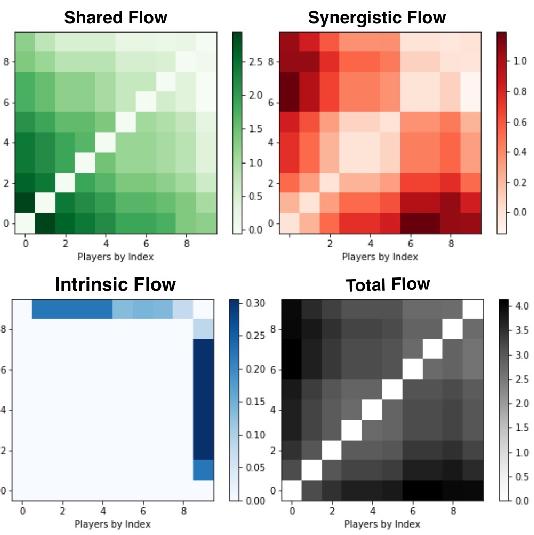
Maxwell's demon is a thought experiment that purports to violate the second law of thermodynamics. Given a gas in a divided container, an all-knowing demon extracts work, for example by inserting and removing a partition, without changing the state of the system. The apparent second-law violation is resolved upon considering the demon itself as part of the system. Hyun Soo Kim (Reed College; advisor Jim Crutchfield) performed computer simulations of a Maxwell's demon arrangement, paying particular attention to the transfer of information during repeated cycles. By identifying "information" with available volume, he was able to define a dimension connected with the information. In his numerics, this dimension varied depending on exactly how the demon operated but reached a maximum of two.
Condensed Matter Experiment
Cicely Potter (Utah Valley University; advisor Shirley Chiang) spent much of the summer troubleshooting a Scanning Tunneling Microscope (STM). Professor Chiang's lab has two main machines: a STM, which can image the surface of materials at a near-atomic length scale, and a low-energy electron microscope (LEEM). The LEEM has lower resolution but can make "movies" showing the time-development of surface structures. Previous LEEM work (described in REU papers from 2014 and 2015) showed that gold atoms on the surface of germanium clump into islands, with the shape of the islands depending on temperature in a reversible way. Using the complementary capabilities of the STM may help understand how this process works. Since the STM had not been used very recently, Cicely helped identify and fix a variety of electrical, vacuum, and mechanical problems, and left the machine in working order.
Claire Onsager (University of Wisconsin Whitewater; advisor Rena Zieve) and Maria Dresser (University of Oregon; advisor Rena Zieve) worked on assembling new experiments to measure quantized vortices in superfluid helium, as well as analyzing data taken previously. That data showed that the fine vibrating wire used to detect the vortices was itself contributing to the measurements in mysterious ways, which must be understood in order to identify properly any effects from the vortices themselves. In particular, rapid changes in temperature dramatically alter the wire's oscillation amplitude, while slow changes in the same temperature range do not. The new experiments planned, with certain changes in the design of the apparatus, should help shed light on the reason behind this effect.
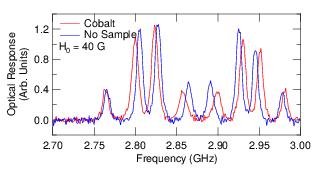
Michael Onyszczak (Iowa State University; advisor Nick Curro) explored the use of nitrogen vacancy centers in diamond in sensitive measurements of magnetic fields. A nitrogen vacancy center is a particular type of defect, where a nitrogen atom is substituted for one carbon atom and in addition an adjacent carbon atom is missing (the "vacancy"). Since the electronic orbitals in a crystal overlap, the defect creates a set of allowed electronic states different from that elsewhere in the diamond. Laser irradiation at a particular energy causes an electronic excitation at the nitrogen vacancy. The levels change in an applied magnetic field, and bringing a sample close to the diamond adds a contribution from both the externally applied field and any magnetization of the sample itself. Michael did a proof of principle measurement, finding distinct magnetic responses in three different materials.
Rapid recent improvements in solar cell performance have been driven by the introduction of better materials. Absorption of light excites pairs of positive and negative charges, and an applied voltage moves them in opposite directions, converting the sunlight into an electrical signal. Eventually each positive charge "recombines" with a negative charge and disappears. One class of candidate materials, hybrid organic-inorganic perovskites, is promising because of the relatively long lifetime of the excited charges and the corresponding long distances they can travel. John Paulus Francia (Butte Community College; advisor Dong Yu) worked towards understanding the source of the long lifetimes in MAPbI3, which may help develop even better compounds. One possible explanation predicts a change in behavior near 160 K. John's measurements did not find such a change. If further work confirms his findings, that suggests that a different explanation for the long lifetime is needed. The pictures below show a schematic of the measurement apparatus and a sample. (The spacing between the two bright copper contact wires is about 8 microns.)
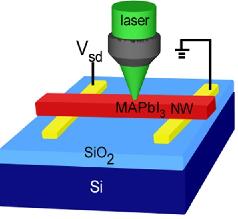

Kelly Neubauer (Gustavus Adolphus College; advisor Valentin Taufour) grew single crystal samples of a series of related materials, which varied in the amount of iron and cobalt they contained. The pure iron compound orders magnetically far above room temperature, with the ordering temperature decreasing as cobalt replaces the iron. There is a second transition at a lower temperature, where the direction of the magnetic moments rotates by ninety degrees. Again, cobalt substitution reduces this temperature, driving it to zero at about 15% cobalt. Kelly mapped out the reorientation transition through magnetization measurements with different orientations of the sample in the applied magnetic field. For one field direction she also found a change in entropy at temperatures the reorientation transition; future measurements will explore the effect further. The ability of the material to convert between magnetic and thermal energy holds out the potential for applications in refrigeration and air conditioning.
Condensed Matter Theory
Thomas Blommel (North Dakota State University; advisor Richard Scalettar) worked on Quantum Monte Carlo computer simulations. He studied a particular model of how electrons and phonons interact within a crystal. Here phonons are the vibrations of the crystal atoms; essentially they are a description of atomic motion in Fourier space rather than real space, and they prove very useful in describing behavior such as scattering of electrons and momentum transfer between electrons and the underlying lattice. The electron-phonon interaction plays a crucial role in many superconductors. The model Thomas used does have a superconducting regime, although he focused on another regime known as a charge density wave. He particularly tried to test a prediction that the behavior of the system should depend only on the ratio of the square of the electron-phonon interaction strength to the phonon frequency. He found that this is true when the frequency is sufficiently small, but that it fails for high frequencies.
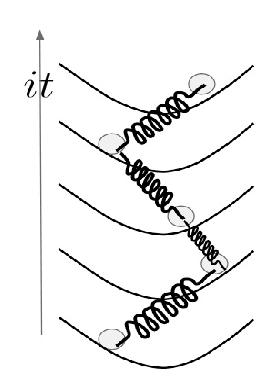

Fields, Strings, Gravity
Causal sets contain discrete points that have some time relationships; i.e., one point may be in the past of another. The time relationships must make sense, in that there are no loops where each point comes after the previous one, and there is an additional condition that no infinite chain of time-ordered points can exist between two fixed points. Jacob Abajian (Trinity University; advisor Steve Carlip) generated causal sets and calculated their dimension using a standard definition. He found that the dimension approaches two for large enough causal sets but drops below two for small sets. This may be related to a drop in the effective dimension of spacetime near the Planck energy.
Measurements on quantum systems, which do not always commute, are represented by opeators which also may not commute. Expectation values of products are often calculated for operators ordered by time, but sometimes calculations for out-of-time-order operators are also needed. Srivatsa Tata (Rutgers University; advisor Mukund Rangamani) worked on how to approximate the out-of-time-order case for a "perturbed" harmonic oscillator that has a small quartic position dependence in addition to the usual quadratic dependence. Sri found relevant formulas and implemented them in Mathematica.
Nuclear Experiment
Maine Christos (Rutgers University; advisors Daniel Cebra and Manuel Calderon de la Barca Sanchez) calculated possible background signals related to the number of mesons observed in heavy-ion collisions that briefly create a quark-gluon plasma. The quark-gluon plasma, formed when energies are high enough to rip apart baryons and free their constituent quarks, should reduce the number of mesons that reach the detector. However, a quantitative measurement of this reduction requires a good understanding of other processes that may also suppress the meson yield. Maine performed detailed calculations of the expected yield of particular mesons in the absence of a quark-gluon plasma.
Particle Experiment

A mismatch between the rotation speeds of galaxies and their mass was the first indication of "dark matter," invisible to our telescopes. The existence of dark matter explains other observations as well, although the measurements suggest that the total mass of the dark matter in the universe is much larger than that of the visible matter. For the past thirty years, physicists have attempted direct observation of dark matter particles, so far without success although they are setting ever more stringent bounds on their possible masses. Since dark matter clearly does interact gravitationally, many detectors rely on dark matter particles colliding with atomic nuclei and setting them in motion. The atoms lose the kinetic energy by emitting electrons and/or photons, which can then be detected. Caroline Paciaroni (Cal Poly San Luis Obispo; advisor Mani Tripathi) worked on calibrating parts of the detector for LZ, a new dark matter search. (The name comes from the initials of two previous experiments, LUX and ZEPLIN, which have now joined forces.) Thoroughly understanding the exact response of the detector to other particles such as neutrinos of stray neutrons is crucial for eventually finding a convincing dark matter signal.